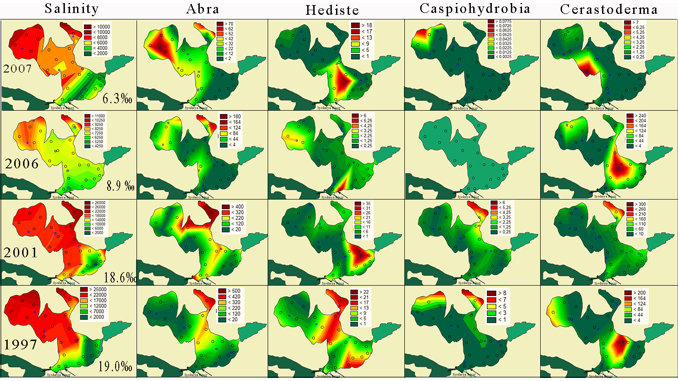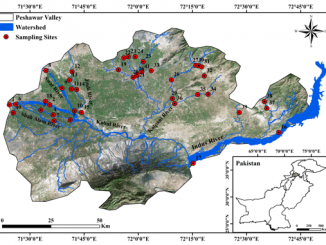
Paper category: Original research paper
Corresponding author: Elena Krupa (elena_krupa@mail.ru)
DOI: 10.2478/ohs-2019-0032
Received: 05/03/2019
Accepted: 26/04/2019
Full text: here
Citation (APA style): Krupa, E. & Grishaeva, O. (2019). Impact of water salinity on long-term dynamics and spatial distribution of benthic invertebrates in the Small Aral Sea. Oceanological and Hydrobiological Studies, 48(4), pp. 355-367. Retrieved 10 Dec. 2019, from doi:10.2478/ohs-2019-0032
Abstract
In 1996–2008, macrozoobenthos of the Small Aral Sea was investigated. A total of 320 macrozoobenthos samples were collected. Statistical analysis and statistical mapping were performed using Statistica and Photoshop software. Ten taxa of macrozoobenthos were identified, with an average water salinity of the Small Aral Sea ranging from 6.3 to 19.0 PSU. Average annual community abundance reached 1962 specimens m<sup>−2</sup>, with biomass of 107.1 g m<sup>−2</sup>. Quantitative variables of macrozoobenthos decreased by an order of magnitude by the end of the analyzed period. The polychaete Hediste diversicolor and mollusks Abra ovata, Cerastoderma glaucum, Caspiohydrobia sp. were the dominant taxa. Statistical mapping and correlation analysis revealed that the high biomass of A. ovata and Caspiohydrobia sp. occur in areas with high water salinity. Aggregations of the mollusk C. glaucum were observed in various areas of the sea. The polychaete H. diversicolor preferred areas with relatively low salinity. Analysis of the results showed that the optimum salinity gradient with Aral salt composition was 17–27 PSU for A. ovata, Caspiohydrobia sp. and C. glaucum, while 1–27 PSU for H. diversicolor. Along with changes in water salinity, the currently growing pressure from freshwater fish is an additional factor affecting the structure of benthic communities in the Small Aral Sea.
References
Abedin, M.A., Habiba, U. & Shaw R. (2014). Community Perception and Adaptation to Safe Drinking Water Scarcity: Salinity, Arsenic, and Drought Risks in Coastal Bangladesh. Int. J. Disaster. Risk. Sci. 5: 110–124. DOI: 10.1007/s13753-014-0021-6.
Aladin, N.V. (1990). Studying the effect of salinization of waters of the detached bays of the Aral Sea on hydrobionts. In N.V. Aladin & L.A. Kuznetsov (Eds.), The present state of the separating bays of the Aral Sea (pp. 4–12). Leningrad, Russia: Zoological Institute. (In Russian).
Aladin, N.V. & Plotnikov, I.S. (1995). Drying of the Aral Sea and possible ways of rehabilitation and conservation of its northern part. In Ya.I. Starobogatov (Ed.), Natural history and biological problems of the Aral Sea and the Aral Sea region (pp.3–16). Saint-Petersburg, Russia: Zoological Institute, Russian Academy of Sciences.
Aladin, N.V. & Plotnikov I.S. (2008). Modern fauna of residual water bodies formed on the place of the former Aral Sea. Proceedings of the Zoological Institute of the Russian Academy of Sciences 312(1/2): 145–154. (In Russian).
Aladin, N.V., Filippov, A.A., Plotnikov I.S., Orlova M.I. & Williams W.D. (1998). Changes in the structure and function of biological communities in the Aral Sea, with particular reference to the northern part (Small Aral Sea), 1985–1994: A review. International Journal of Salt Lake Research 7: 301–343. DOI: 10.1023/A:1009009924839.
Aladin, N., Crétaux, J.-F., Plotnikov, I.S., Kouraev, A.V., Smurov, A.O. et al. (2005). Modern hydro-biological state of the Small Aral Sea. Environmetrics 16: 375–392. DOI: 10.1002/env.709.
Aladin, N., Micklin, P. & Plotnikov, I. (2008). Biodiversity of the Aral Sea and its importance to the possible ways of rehabilitating and conserving its remnant water bodies. In J. Qi & K.T. Evered (Eds.), Environmental Problems of Central Asia and their Economic, Social and Security Impacts (pp. 73–98). Dordrecht: Springer. DOI: 10.1007/978-1-4020-8960-2_5.
Aladin, N.V., Plotnikov, I.S., Micklin, P. & Ballatore, T. (2009). The Aral Sea: Water level, salinity and long-term changes in biological communities of an endangered ecosystem – past, present and future. Natural Resources and Environmental Issues 15: 177–183.
Aladin, N.V., Gontar, V.I., Zhakova, L.V., Plotnikov, I.S., Smurov et al. (2018). The zoocenosis of the Aral Sea: six decades of fast-paced change. Environmental Science and Pollution Research 26(3): 2228–2237. DOI: 10.1007/s11356-018-3807-z.
Alekin, O.A. & Lyakhin, Yu.I. (1984). Chemistry of the ocean. Leningrad, Russia: Gidrometeoizdat. (In Russian).
Andreev, N.I. (1999). Hydro-fauna of the Aral Sea in conditions of environmental crisis. Omsk, Russia: Publishing house of Omsk State Pedagogical University. (In Russian).
Andreev, N.I. & Andreeva, S.I. (1983). Survival of the mollusk Abra ovata (Phill.) in the Aral water with different salinity. In A.M. Mukhamediev (Ed.), The biological basis of fisheries in water bodies of Central Asia and Kazakhstan (pp. 47–48). Tashkent, Uzbekistan: FAN. (In Russian).
Andreev, N.I. & Andreeva, S.I. (1990a). Salinity resistance of some mass invertebrates of the Aral Sea. The current state of the Aral Sea under conditions of progressive salinization (pp. 86–105). Leningrad, Russia: Zoological Institute. (In Russian).
Andreev, N.I. & Andreeva, S.I. (1990b). Zoobenthos of kultuk (shallow bays) of the Aral Sea before and after the regulation of river flow (on the situation of the horohaline zone in the Aral Sea). The current state of the Aral Sea under conditions of progressive salinization (pp. 54–67). Leningrad, Russia: Zoological Institute. (In Russian).
Andreev, N.I., Andreeva, S.I. & Filippov, A.A. (1990). Zoobenthos of the Aral Sea under conditions of progressive salinization. In O.A. Scarlatto (Ed.), The current state of the Aral Sea under conditions of progressive salinization (pp. 24–29). Leningrad, Russia: Zoological Institute. (In Russian).
Andreev, N.I., Andreeva, S.I., Filippov, A.A. & Aladin, N.V. (1992). The fauna of the Aral Sea in 1989. The benthos. Int. J. Salt Lake Res. 1: 103–110. DOI: 10.1007/BF02904954.
Armstrong, R.A., Rittger, K., Brodzik, M.J., Racoviteanu, A., Barrett, A.P. et al. (2018). Runoff from glacier ice and seasonal snow in High Asia: separating melt water sources in river flow. Regional Environmental Change. Published Online. DOI: 10.1007/s10113-018-1429-0.
Balymbetov, K.S. & Grishaeva, O.V. (2005). Fodder base of fish of the Small Aral Sea in 2001–2004. In Sh.A. Alpeysov (Ed.), Fisheries research in the Republic of Kazakhstan: history and current status (pp. 406–417). Almaty, Kazakhstan: Bastau.
Barulin Yu.A. (1984). Guidelines for the collection and processing of materials in hydrobiological studies on freshwater bodies of water. Zoobenthos and its products. Leningrad, Russia: State Fisheries Research Institute.
Bogutskaya. N.G., Kiyashko. P.V., Naseka. A.M., Orlova. M.I. (2013). Key to fish and invertebrates of the Caspian Sea. Fish and mollusk. St. Petersburg, Moscow, Russia: Partnership of scientific publications. T. 1.
Bortnik, V.N. & Chistyaevaya, S.P. (1990). Hydrometeorology and hydrochemistry of the seas of the USSR. The Aral Sea. Leningrad, Russia: Gidrometeoizdat. (In Russian).
Eimanifar, A. & Mohebbi, F. (2007). Urmia Lake (Northwest Iran): a brief review. Saline Systems 3(5): 1–8. DOI: 10.1186/1746-1448-3-5.
Ermakhanov, Z.K., Plotnikov, I.S., Aladin, N.V. & Micklin P. (2012). Changes in the Aral Sea ichthyofauna and fishery during the period of ecological crisis. Lakes & Reservoirs: Research and Management 17: 3–9. DOI: 10.1111/j.1440-1770.2012.00492.x.
Filippov, A.A. (1996). Macrozoobenthos in the inshore zone of the Northern Aral Sea. International Journal of Salt Lake Research. 5(4): 315–327. DOI: 10.1007/BF01995384.
Filippov, A.A. (2001). Macrozoobenthos of the Small Aral Sea. Russian Journal of Marine Biology 27(6): 401–406. DOI: 10.1023/A:1013713706694.
Gaybullaev, B., Chen, S.-Ch. & Gaybullaev, D. (2012). Changes in water volume of the Aral Sea after 1960. Appl. Water Sci. 2: 285–291. DOI: 10.1007/s13201-012-0048-z.
Grishaeva, O.V. (2005). On the nutrition of flounder-glossy of the Aral Small Sea. In Proceedings of the 3rd International Scientific and Practical Conference: Problems of conservation and rational use of biodiversity of the Caspian Sea and adjacent regions (pp. 94–96). Elista, Russia: Kalmyk book publishing house.
Grishaeva, O.V. (2009). Distribution of flounder and macrozoobenthos of the Small Aral Sea. Bulletin of the Kazakh National University 2(41): 41–45.
Güneş, E., Şahin, T. & Düzgüneş, E. (2011). Age, growth, and reproduction of flounder (Platichthys flesus luscus Pallas, 1811) in the south-eastern Black Sea. Turkish Journal of Science & Technology 6(2): 53–59.
Karpevich, A.F. (1975). Theory and practice of acclimatization of aquatic organisms. Moscow, Russia: Food industry.
Karthe, D., Abdullaev, I., Boldgiv, B., Borchardt, D., Chalov, S. et al. (2017). Water in Central Asia: an integrated assessment for science-based management. Environ. Earth. Sci. 76(690): 1–15. DOI: 10.1007/s12665-017-6994-x.
Khlebovich, V.V. & Aladin, N.V. (2010). The salinity factor in animal life. Herald of the Russian Academy of Sciences 80(3): 299–304.
Kocheshkova, O.V., Еzhova, Е.Е. & Lange, Е.К. (2012). Feeding peculiarities of two polychaeta species in the Vistula lagoon, Baltic Sea. Sea ecological Journal 2(11): 45–51.
Kosarev, A.N. (1975). Hydrology of the Caspian and Aral Seas. Moscow, Russia: Moscow State University.
Krupa, E.G. & Grishaeva, O.V. (2011). The structure of species dominance in the macrozoobenthos of the Small Aral Sea as an indicator of changes in salinity. In Bioindication in the monitoring of freshwater ecosystems: Abstracts of the 2nd International Conference (p. 96). St. Petersburg, Russia: Institute of Lake Science. (In Russian).
Malinovskaya, L.V. & Zinchenko, T.D. (2011). Long-term dynamics of the biomass of the introduced species Hediste diversicolor Müller and Abra ovata (Philippi) in the North Caspian Sea. Russ. J. Biol. Invasions. 2(1): 20–28. DOI: 10.1134/S2075111711010048.
Meng, K., Shi, X.H., Wang, E. & Liu, F. (2012). High-altitude salt lake elevation changes and glacial ablation in Central Tibet, 2000–2010. Chin. Sci. Bull. 57: 525–534. DOI: 10.1007/s11434-011-4849-5.
Micklin, P. (2014). Introduction to the Aral Sea and its region. In P. Micklin, N. Aladin & I. Plotnikov (Eds.) The Aral Sea. Springer Earth System Sciences, 10178. (pp. 15–40). Berlin, Heidelberg: Springer. DOI: 10.1007/978-3-642-02356-9_2.
Muus, B.J. & Nielsen, J.G. (1999). Sea Fish. Scandinavian Fishing Year Book. Denmark: Hedehusene.
Neuhoff, H.-G. (1979). Influence of temperature and salinity on food conversion and growth of different Nereis species (Polychaeta, Annelida). Mar. Ecol. Prog. Ser. 1: 255–262.
Pankratova, V.Ya. (1977). Larvae and pupae of mosquitoes of the subfamily Podonominae and Tanypodinae of the USSR fauna. Leningrad, Russia: Enlightenment. (In Russian).
Plotnikov, I. (2013). Changes in the species composition of the Aral Sea free-living invertebrates (Metazoa). Proceedings of the Zoological Institute of the Russian Academy of Sciences. 3: 41–54. (In Russian).
Plotnikov, I.S., Aladin, N.V., Ermakhanov, Z.K., Zhakova, L.V. (2014). Biological dynamics of the Aral Sea before its modern decline (1900–1960). In P. Micklin, N. Aladin & I. Plotnikov (Eds.), The Aral Sea (pp. 41–46). Springer Earth System Sciences, vol. 10178. Berlin, Heidelberg: Springer.
Plotnikov, I.S., Aladin, N.V. (2014). The Biological Future of the Aral Sea. In P. Micklin, N. Aladin & I. Plotnikov (Eds.), The Aral Sea (pp. 355–359). Springer Earth System Sciences, vol. 10178. Berlin, Heidelberg: Springer. DOI: 10.1007/978-3-642-02356-9_14.
Pokhrel, Y.N., Felfelani, F., Shin, S., Yamada, T.J. & Satoh, Y. (2017). Modeling large‑scale human alteration of land surface hydrology and climate. Geosci. Lett. 4(10): 1–13. DOI: 10.1186/s40562-017-0076-5.
Sapozhnikov, P.V., Arashkevich, E.G., Ivanishcheva, P.S. (2010). Biodiversity. In A. Kostianoy & A. Kosarev (Eds.), The Aral Sea Environment. The Handbook of Environmental Chemistry (pp. 235–282). Vol. 7. Berlin, Heidelberg: Springer. DOI: 10.1007/698_2009_36.
Semenova, A.D. (1977). Guideline for chemical analysis of surface water. Leningrad: Gidrometeoizdat. (In Russian).
Semin, V.L. (2011). The dependence of the characteristics of the Polychaeta taxocene in the Sea of Azov on abiotic factors. Bulletin of the Southern Scientific Center of the Russian Academy of Sciences. 7(2): 69–77. (In Russian).
Shilova, A.I. (1976). Chironomids of Rybinsk reservoir. Leningrad, Russia: Science. (In Russian).
Tsalolikhin, S.Y. (1995). Key to freshwater invertebrates in Russia and adjacent territories. St. Petersburg, Russia: Science. T. 2.
United Nations Educational, Scientific and Cultural Organization (UNESCO) (2017). Aral Sea and Priaralye. Tashkent, Uzbekistan, UNESCO: Baktria press.
Vorobiev, V.P. (1949). Benthos of the Sea of Azov. Simferopol, Russia: Crimean publishing house. (In Russian).
Wu, J., Liu, W., Zeng, H., Ma, L. & Bai, R. (2014). Water quantity and quality of six lakes in the arid Xinjiang region, NW China. Environ. Process. 1: 115–125. DOI: 10.1007/s40710-014-0007-9.
Zhitomirskaya, O.M. (1964). Climatic description of the Aral Sea region. Leningrad, Russia: Hydrometeorological Publishing House. (In Russian).


Bądź pierwszy, który skomentuje ten wpis